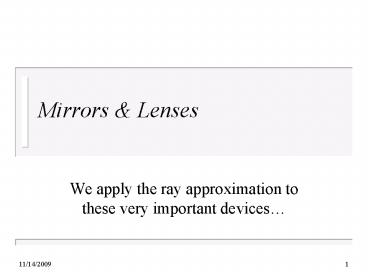Mirrors PowerPoint PPT Presentation
1 / 18
Title: Mirrors
1
Mirrors Lenses
- We apply the ray approximation to these very
important devices
2
Mirrors
- Law of reflection still holds.
- Angle of reflection Angle of incidence
- Object distance p
- Image distance q
- Plane mirrors
- p q.
- Image is upright,
- Image is unmagnified,
- Image is virtual.
3
Real Images Virtual Images
- A real image is formed when the light rays
actually come from the image point (location. - A real image can be projected.
- A virtual image is formed when the light rays
only appear to come from the image point. - A virtual image can NOT be projected.
4
(Lateral) Magnification
- Suppose the object has a height h,
- and the image has a height h,
- The Lateral Magnification is the ratio of image
height to object height.
- For a plane mirror, M 1
5
(No Transcript)
6
Problem
- A woman can see an object clearly when its held
at a distance of 25 cm from her eyes. How far
should she hold a flat mirror to see her own
image clearly? - 12.5 cm
7
Problem
- A man is walking at 1.0 m/s directly toward a
flat mirror. At what speed is his image
approaching him? - 2.0 m/s
8
Rearview Mirror
9
Spherical Mirrors
- We shall specialize to sections of spherical
mirrors. - The spherical mirror will have a center of
curvature C and a radius of curvature R. - The principal axis connects C with the center of
the mirror. - The Law of Reflection still holds.
10
Mirror Equation
- p is the object distance measured along the
principal axis. - q is the image distance.
- R is the radius of curvature.
- f is the focal length.
11
Rules for Ray diagrams
- p, q, R, f can be positive or negative.
- Concave mirrors
- Both f and R are if the center of curvature is
in front of the mirror. - Convex mirrors
- Both f and R are if the center of curvature is
in back of the mirror. - If the image is upright, Mgt0.
- If the image is inverted, Mlt0.
12
Rules for Ray diagrams 2
- Learn 3 rays to locate the image.
- Ray drawn parallel to principal axis and is
reflected through the focal point F. - Ray drawn through the focal point is reflected
back parallel to the principal axis. - Ray drawn through the center of curvature C, is
reflected back on itself.
- The image above is real and inverted.
- The magnification is negative and M lt 1.
13
Problem
- An 5 cm candle is placed 35 cm in front of a
concave spherical mirror with a radius of
curvature of 30 cm. Find the location of the
image, its height and the magnification of the
image. - Is the image real or virtual?
Real
14
Problem
- An 5 cm candle is placed 10 cm in front of a
concave spherical mirror with a radius of
curvature of 30 cm. Find the location of the
image, its height and the magnification of the
image. - Is the image real or virtual?
Virtual
15
Convex Mirrors
- These have negative f and R.
- The focal point and center of curvature you aim
is on the back side of the mirror. - For a single convex mirror, the image will always
be virtual and smaller.
16
Problem
- An 5 cm candle is placed 10 cm in front of a
convex spherical mirror with a radius of
curvature of 30 cm. Find the location of the
image, its height and the magnification of the
image. - Is the image real or virtual?
Virtual
17
Caveat
- These rules are an approximation.
- If the rays of light make large angles with the
principal axis, then the image will not be sharp.
- Spherical Aberration.
- Parabolic mirrors do not suffer spherical
aberration. - But spherical mirrors are easy to make.
18
Problems for concave mirrors
- If the object is infinitely far away, where is
the image? - If the image is infinitely far away, where is the
object? - Is it possible to have an image with M 1?
- Where should the object be in order to have a
magnification of 2?

